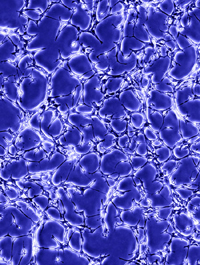
A new technique allows researchers to culture colonies of mouse brain stem cells that can either propagate without differentiating or become normal brain cells at the flip of a genetic switch. (Conti, et al.)It's hard to grow stem cells in a dish. In particular, while it is possible to multiply mouse embryonic stem cells in culture, propagating stem cells that are specific to distinct tissues (e.g. neural stem cells) has proven to be a challenge. Neural stem cells are normally found in a specialized environment known as a neurosphere, which is thought to provide the necessary cellular signals to maintain populations of these undifferentiated cells.
In a new paper published in the open-access journal PLoS Biology, Austin Smith and colleagues have developed a method to propagate mouse brain stem cells derived from ES cells. Their novel method creates an on/off switch for differentiation of tissue-specific stem cells: they can multiply without differentiation, and they can also become normal brain cells. The authors also managed to cultivate the brain stem cells without re-creating the rarefied neurosphere.
To grow their stem cells, Smith et al. combined epidermal growth factor (EGF) and fibroblast growth factor (FGF), two small proteins that bind to stem cells and promote growth. Previously, scientists had grown brain stem cells with FGF. Upon removing FGF, the cells failed to differentiate and become mature. The cells that Smith et al. grew, in contrast, became mature cells upon removal of the growth factor cocktail. They observed both neurons and astrocytes, the two types of cells into which the brain stem cells mature.
In the future, scientists may use this new technique to produce large quantities of the cells to study their basic properties and also to explore their value for treating neurodegenerative afflictions, including Huntington disease, Parkinson disease, and Alzheimer disease.
Citation: Conti L, Pollard SM, Gorba T, Reitano E, Toselli M, et al. (2005) Niche-independent symmetrical self-renewal of a mammalian tissue stem cell. PLoS Biol 3(9): e283.
Source : Public Library of Science
 Print Article
Print Article Mail to a Friend
Mail to a Friend
